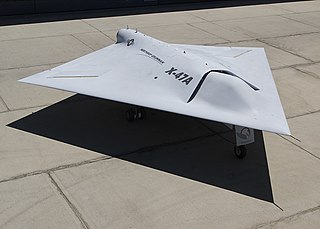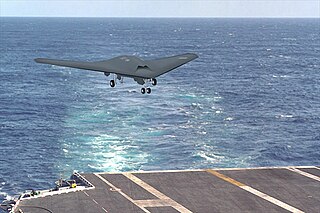
An unmanned combat aerial vehicle (UCAV), also known as a combat drone, colloquially shortened as drone or battlefield UAV, is an unmanned aerial vehicle (UAV) that is used for intelligence, surveillance, target acquisition, and reconnaissance and carries aircraft ordnance such as missiles, ATGMs, and/or bombs in hardpoints for drone strikes. These drones are usually under real-time human control, with varying levels of autonomy. Unlike unmanned surveillance and reconnaissance aerial vehicles, UCAVs are used for both drone strikes and battlefield intelligence.

The McDonnell DouglasT-45 Goshawk is a highly modified version of the British BAE Systems Hawk land-based training jet aircraft. Manufactured by McDonnell Douglas and British Aerospace, the T-45 is used by the United States Navy as an aircraft carrier-capable trainer.

The Northrop Grumman X-47 is a demonstration unmanned combat aerial vehicle. The X-47 began as part of DARPA's J-UCAS program, and is now part of the United States Navy's UCAS-D program to create a carrier-based unmanned aircraft. Unlike the Boeing X-45, initial Pegasus development was company-funded. The original vehicle carries the designation X-47A Pegasus, while the follow-on naval version is designated X-47B.

The Dassault nEUROn is an experimental unmanned combat aerial vehicle (UCAV) being developed with international cooperation, led by the French company Dassault Aviation. Countries involved in this project include France, Greece, Italy, Spain, Sweden and Switzerland. The design goal is to create a stealthy, autonomous UAV that can function in medium-to-high threat combat zones.
Hunter-Killer is an unofficial project name based upon an Aviation Week & Space Technology article. The U.S. Air Force's Hunter-Killer program was a tactical unmanned combat air vehicles (UCAV) procurement program. The General Atomics MQ-9 Reaper, a variant of the MQ-1 Predator won the project and was deployed in Afghanistan.

Joint Unmanned Combat Air Systems, or J-UCAS, was the name for the joint U.S. Navy and U.S. Air Force unmanned combat air vehicle procurement project. The two vehicles involved in the project were the Boeing X-45 and Northrop Grumman X-47. J-UCAS was managed by the Defense Advanced Research Projects Agency. In the 2006 Quadrennial Defense Review, it was stated that the J-UCAS program would be terminated and instead a new long-range strategic bomber program, "Next-Generation Bomber", for the Air Force has been launched. The program was revitalized into a Navy-only program named UCAS-D.

Boeing Phantom Works is the advanced prototyping arm of the defense and security side of Boeing. Its primary focus is developing advanced military products and technologies, many of them highly classified.

The Boeing X-46 was a proposed unmanned combat air vehicle (UCAV) that was to be developed in conjunction with the United States Navy and DARPA as a naval carrier-based variant of the Boeing X-45 UCAV being developed for the U.S. Air Force. Two contracts for technology demonstrators were awarded in June 2000, to Boeing for the X-46A and to Northrop Grumman for the X-47A.

The history of unmanned combat aerial vehicles (UCAVs) is closely tied to the general history of unmanned aerial vehicles (UAVs). While the technology dates back at least as far as the 1940s, common usage in live operations came in the 2000s. UCAVs have now become an important part of modern warfare, including in the Syrian civil war, the 2020 Nagorno-Karabakh war and during the 2022 Russian invasion of Ukraine.

The Boeing A160 Hummingbird is an unmanned aerial vehicle (UAV) helicopter. Its design incorporates many new technologies never before used in helicopters, allowing for greater endurance and altitude than any helicopter currently in operation.

The Northrop Grumman X-47B is a demonstration unmanned combat aerial vehicle (UCAV) designed for aircraft carrier-based operations. Developed by the American defense technology company Northrop Grumman, the X-47 project began as part of DARPA's J-UCAS program, and subsequently became part of the United States Navy's Unmanned Combat Air System Demonstration (UCAS-D) program. The X-47B is a tailless jet-powered blended-wing-body aircraft capable of semi-autonomous operation and aerial refueling.

The Mikoyan Skat is a concept of a stealth unmanned combat aerial vehicle (UCAV) being developed by Mikoyan for the Russian Ministry of Defence since 2005.

Aurora Flight Sciences is an American aviation and aeronautics research subsidiary of Boeing which primarily specializes in the design and construction of special-purpose Unmanned aerial vehicles. Aurora has been established for 20+ years and their headquarters is at the Manassas Regional Airport in Manassas, Virginia.

The Boeing Phantom Ray is an American demonstration stealth unmanned combat air vehicle (UCAV) developed by Boeing using company funds. The autonomous Phantom Ray is a flying wing around the size of a conventional fighter jet, and first flew in April 2011. It will conduct a program of test flights involving surveillance, ground attack and autonomous aerial refueling missions. The developers say it can carry 4,500 pounds of payload.

Ghatak is an autonomous jet powered stealthy unmanned combat air vehicle (UCAV), being developed by Aeronautical Development Establishment (ADE) of the Defence Research and Development Organisation (DRDO) for the Indian Air Force. The design work on the UCAV is to be carried out by Aeronautical Development Agency (ADA). Autonomous Unmanned Research Aircraft (AURA) was a tentative name for the UCAV. Details of the project are classified.

KQ-X was a $33 million DARPA program awarded to Northrop Grumman on July 1, 2010. KQ-X investigated and developed autonomous aerial refueling techniques using two NASA Global Hawk high-altitude long endurance (HALE) unmanned aerial vehicles (UAVs).
The Lockheed Martin Sea Ghost was a proposal to fulfill the United States Navy's requirement for an Unmanned Carrier-Launched Airborne Surveillance and Strike aircraft.

The Unmanned Carrier-Launched Airborne Surveillance and Strike (UCLASS) was a United States Navy program to develop an autonomous carrier-based unmanned combat aerial vehicle providing an unmanned intelligence and strike asset to the fleet. After debate over whether the UCLASS should primarily focus on stealthy bombing or scouting, the Pentagon instead changed the program entirely into the Carrier-Based Aerial-Refueling System (CBARS) to create a UAV for aerial refueling duties to extend the range of manned fighters, which led to the Boeing MQ-25 Stingray.

Collaborative combat aircraft (CCA) is a US program for unmanned combat air vehicles (UCAVs) that is considered broadly equivalent to a loyal wingman. CCAs are intended to operate in collaborative teams with the next generation of manned combat aircraft, including sixth-generation fighters and bombers such as the Northrop Grumman B-21 Raider. Unlike the conventional UCAVs, the CCA incorporates artificial intelligence (AI), denoted an "autonomy package", increasing its survivability on the battlefield. It is still expected to cost much less than a manned aircraft with similar capabilities. The US Air Force plans to spend more than $6 billion on its CCA programs from 2023 to 2028. The success of the CCA program may lessen the need for additional manned squadrons.





















